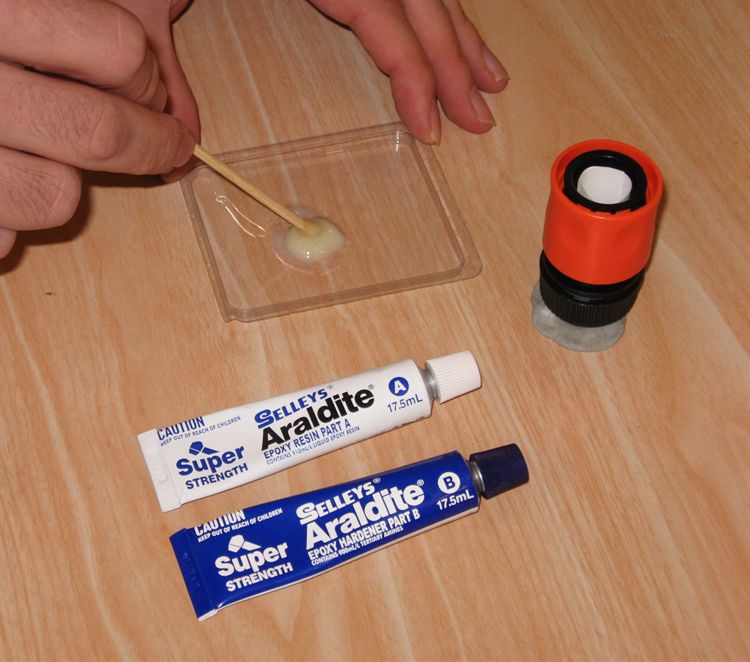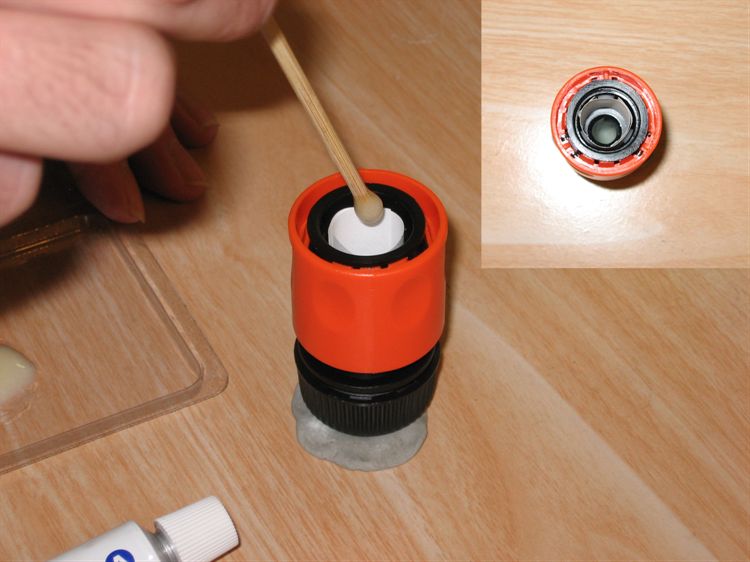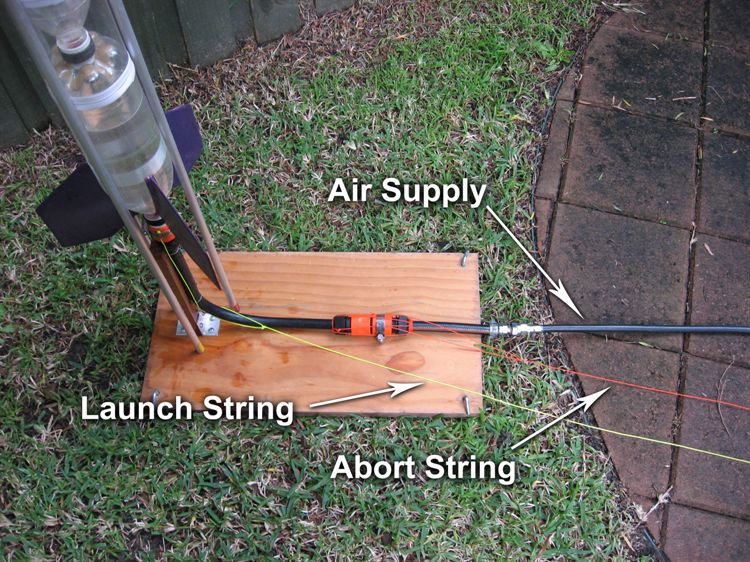Water Rocket Launch Abort Valve
by air.command in Workshop > Science
31777 Views, 43 Favorites, 0 Comments
Water Rocket Launch Abort Valve

The purpose of this tutorial is to build a simple remotely operated pressure release valve out of common materials requiring no special tools.
Background
An abort valve is a very important safety feature of a launcher. On occasions you will encounter a situation where an already pressurised rocket needs to be prevented from leaving the pad and pressure in the rocket needs to be released. Some reasons for aborting a launch include:
You may want to prevent water from going back down the air line for two main reasons:
It should be possible to attach this mechanism to the air line of most existing launchers if they're not already fitted with non-return valves. In the procedure below we integrate a simple non-return valve into the pressure release valve.
For more water rocket construction tutorials please visit:
http://www.AirCommandRockets.com
Background
An abort valve is a very important safety feature of a launcher. On occasions you will encounter a situation where an already pressurised rocket needs to be prevented from leaving the pad and pressure in the rocket needs to be released. Some reasons for aborting a launch include:
- The recovery system malfunctions or accidentally deploys while the rocket is still on the pad.
- The range may become unsafe such as when people, vehicles or animals enter the range.
- A slow leak may develop that might lead to a catastrophic failure if pressure is not released quickly.
You may want to prevent water from going back down the air line for two main reasons:
- Keep as much of the water in the rocket as possible.
- The water may damage your pump if it is designed only for air.
It should be possible to attach this mechanism to the air line of most existing launchers if they're not already fitted with non-return valves. In the procedure below we integrate a simple non-return valve into the pressure release valve.
For more water rocket construction tutorials please visit:
http://www.AirCommandRockets.com
Materials Needed

- 2 x Gardena quick connectors
- Gardena extension adaptor
- Hose clamp
- Epoxy glue
- Sewing pin with a round head
- Nylon String
Tools Needed

- Scissors
- Drill
- Screwdriver
- Sandpaper
- Pliers
- Blu-Tack / plasticine / modelling clay
Procedure

If you are going to fit this mechanism to a launcher that does not require a non-return valve then you can skip steps 3 - 9.
We start with an integrated non-return valve.
Procedure
Sand the internal hole of the Gardena quick connector.
We start with an integrated non-return valve.
Procedure
Sand the internal hole of the Gardena quick connector.

Put a piece of Blu-Tack, plasticine or modelling clay on the workbench and stand the Gardena connector on it's end (orange collar pointing up) so that the Blu-Tack blocks the central hole. You may want to make a protective cylinder from a piece of paper so that you don't get glue on the inside walls near the top of the coupling.


Mix up some epoxy and carefully pour it through the open end. Pour enough epoxy in so that it is about 1cm deep.

Let the epoxy fully cure for at least 24 hours. It is better to use the longer cure but stronger epoxy than the 5 minute stuff.

When the epoxy has cured, drill a small hole through the center of the epoxy. The hole should be smaller than the head of the pin. Usually about 1.5 - 2mm is good.

Insert the pin so that the head is on the inside of the coupling. With the sharp end pointing out of the hole.

Cut the sharp point off and bend the end of the pin 90 degrees. The bent section should be about 3 mm and there needs to be about 5mm movement of the pin. This is the non-return valve.
Pressure Release Valve

For illustration we show the launch abort valve fitted to a simple Gardena launcher.

Here we cut the garden hose air line where we want to fit the abort valve.

Insert the two hoses into the respective couplings making sure that the one with the non-return valve is closer to the air source. Tighten the coupling nuts to secure the hoses. Snap the extension adaptor into the hoses to check to make sure everything fits.


Put a hose clamp around the coupling with the non-return valve and pinch two ends of loop made from a short length of string under it.
Tie a string around the hose near the base of the coupling and run it to the other hose near the base of the other coupling and tie it off. Do this three or four times around the couplings. Make sure that there is enough slack in the lines to allow about 2 cm of movement.
Tie a string around the hose near the base of the coupling and run it to the other hose near the base of the other coupling and tie it off. Do this three or four times around the couplings. Make sure that there is enough slack in the lines to allow about 2 cm of movement.

The pressure release valve is now complete. You will want to attach the hose near the rocket to the launcher so that it does not move when you pull on the abort string.
Connect a long string to the short loop on the valve. Make the string as long as your launch string. It is a good idea to make it a different colour so that you don't accidentally pull the wrong one.
NOTES:
1. If you use an air hose that is a different diameter to the garden hose used in this example, you can use a short lengths of garden hose connected to the couplings, and make hose adapters for your specific air hose. There are many adaptors available on-line or from your local hardware store. Here some examples:
http://www.fittingsandadapters.com/brasshosebarbs.html
http://www.justoffbase.co.uk/Tool-Shop/Air-Hose-Connectors
You can also easily insert a inner tube (Schrader) valve into the end of the hose and use a small hose clamp to secure it in place. Be aware that these don't work as non-return valves when the air hose is connected to them.
2. You should be able to use brass Gardena couplings or similar quick connect fittings if you wish to use higher pressures, but make sure that any connected hoses are also rated for the appropriate pressures.
3. To reset the valve simply click the couplings back together.
4. The simple 'pin' non-return valve is less than ideal, but for the most part it should seal well.
5. You may find a Gardena quick connector that already has a non-return valve built in. These are unsuitable as the valve only operates when nothing is snapped into the connector.
References
http://www.AirCommandRockets.com
Connect a long string to the short loop on the valve. Make the string as long as your launch string. It is a good idea to make it a different colour so that you don't accidentally pull the wrong one.
NOTES:
1. If you use an air hose that is a different diameter to the garden hose used in this example, you can use a short lengths of garden hose connected to the couplings, and make hose adapters for your specific air hose. There are many adaptors available on-line or from your local hardware store. Here some examples:
http://www.fittingsandadapters.com/brasshosebarbs.html
http://www.justoffbase.co.uk/Tool-Shop/Air-Hose-Connectors
You can also easily insert a inner tube (Schrader) valve into the end of the hose and use a small hose clamp to secure it in place. Be aware that these don't work as non-return valves when the air hose is connected to them.
2. You should be able to use brass Gardena couplings or similar quick connect fittings if you wish to use higher pressures, but make sure that any connected hoses are also rated for the appropriate pressures.
3. To reset the valve simply click the couplings back together.
4. The simple 'pin' non-return valve is less than ideal, but for the most part it should seal well.
5. You may find a Gardena quick connector that already has a non-return valve built in. These are unsuitable as the valve only operates when nothing is snapped into the connector.
References
- The "Pin" non-return valve concept was adapted from the "Crushing Sleeve" mechanism described on Paul Grosse's page here: http://ourworld.compuserve.com/homepages/pagrosse/h2orstaging.htm
http://www.AirCommandRockets.com